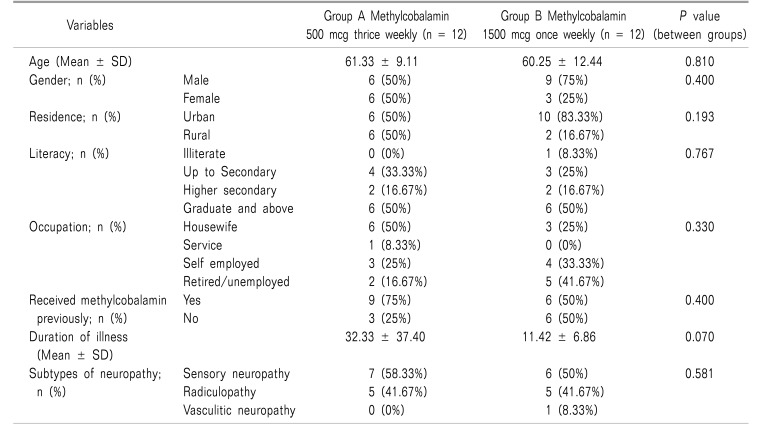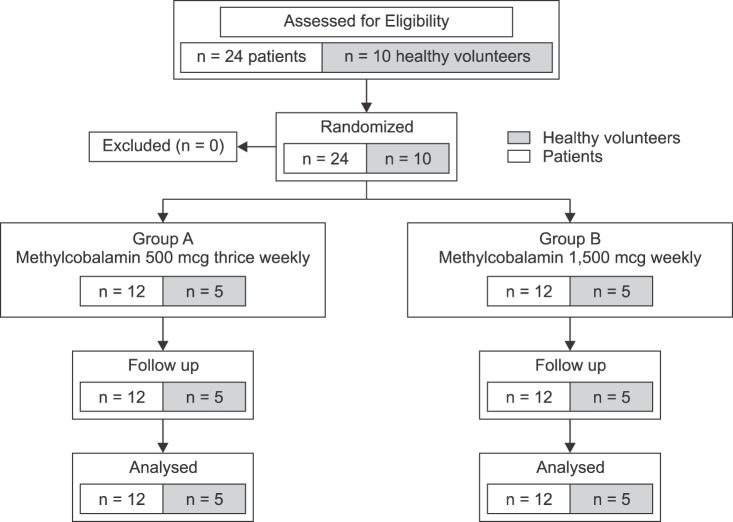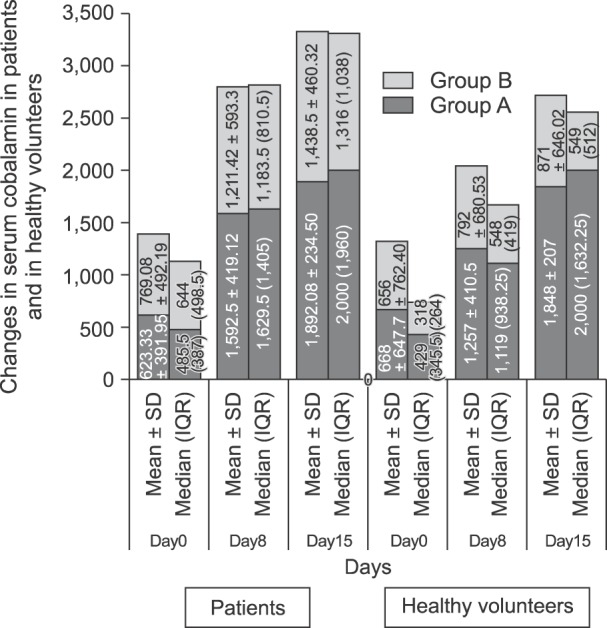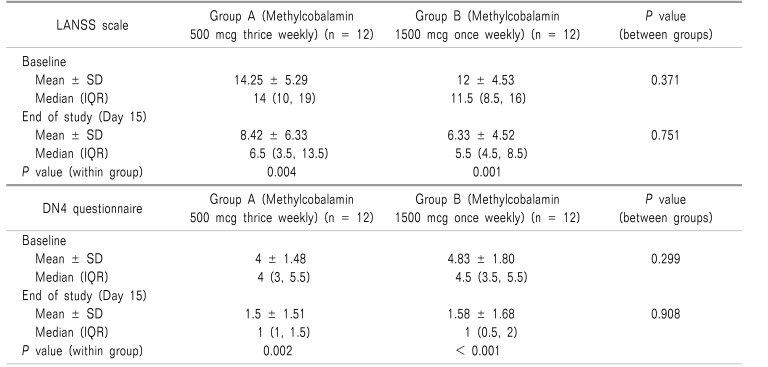1. Zagar BR, Longyhore DS. Evaluating the association between vitamin B12 deficiency and peripheral neuropathy in patients with diabetes. Int J Med Pharm. 2014; 2:1–10.

2. Briani C, Dalla Torre C, Citton V, Manara R, Pompanin S, Binotto G, et al. Cobalamin deficiency: clinical picture and radiological findings. Nutrients. 2013; 5:4521–4539. PMID:
24248213.

3. Oh R, Brown DL. Vitamin B12 deficiency. Am Fam Physician. 2003; 67:979–986. PMID:
12643357.
4. Leishear K, Boudreau RM, Studenski SA, Ferrucci L, Rosano C, de Rekeneire N, et al. Relationship between vitamin B12 and sensory and motor peripheral nerve function in older adults. J Am Geriatr Soc. 2012; 60:1057–1063. PMID:
22690982.

5. Healton EB, Savage DG, Brust JC, Garrett TJ, Lindenbaum J. Neurologic aspects of cobalamin deficiency. Medicine (Baltimore). 1991; 70:229–245. PMID:
1648656.

6. Soneji N, Peng PW. Ultrasound-guided pain interventions - a review of techniques for peripheral nerves. Korean J Pain. 2013; 26:111–124. PMID:
23614071.

7. McCombe PA, McLeod JG. The peripheral neuropathy of vitamin B12 deficiency. J Neurol Sci. 1984; 66:117–126. PMID:
6097649.

8. Amador N. Vitamin B12 replacement therapy and its rehabilitative effects on psychiatric and neurologic symptoms. Nutrition Bytes. 1998; 4.
9. Aaron S, Kumar S, Vijayan J, Jacob J, Alexander M, Gnanamuthu C. Clinical and laboratory features and response to treatment in patients presenting with vitamin B12 deficiency-related neurological syndromes. Neurol India. 2005; 53:55–58. PMID:
15805657.

10. Gupta JK. A review on hyperhomocysteinemia and its risk factors. Innovare J Med Sci. 2016; 4:11–14.
11. Mizukami H, Ogasawara S, Yamagishi S, Takahashi K, Yagihashi S. Methylcobalamin effects on diabetic neuropathy and nerve protein kinase C in rats. Eur J Clin Invest. 2011; 41:442–450. PMID:
21128935.

12. Mutiawati E, Meliala L, Aji D, Wasito W, Muchlisin ZA. A preliminary study on the effect of methylcobalamin application on reducing neuropathic pain. HVM Bioflux. 2015; 7:101–103.
13. Yaqub BA, Siddique A, Sulimani R. Effects of methylcobalamin on diabetic neuropathy. Clin Neurol Neurosurg. 1992; 94:105–111. PMID:
1324807.

14. Yamane K, Usui T, Yamamoto T, Tsukamoto T, Soma Y, Yoshimura N, et al. Clinical efficacy of intravenous plus oral mecobalamin in patients with peripheral neuropathy using vibration perception thresholds as an indicator of improvement. Curr Ther Res Clin Exp. 1995; 56:656–670.

15. Chatterjee S, Dureja GP, Kadhe G, Mane A, Phansalkar AA, Sawant S, et al. Cross-sectional study for prevalence of non-steroidal anti-inflammatory drug-induced gastrointestinal, cardiac and renal complications in India: interim report. Gastroenterology Res. 2015; 8:216–221. PMID:
27785299.

16. Bennett M. The LANSS Pain Scale: the leeds assessment of neuropathic symptoms and signs. Pain. 2001; 92:147–157. PMID:
11323136.

17. Bouhassira D, Attal N, Alchaar H, Boureau F, Brochet B, Bruxelle J, et al. Comparison of pain syndromes associated with nervous or somatic lesions and development of a new neuropathic pain diagnostic questionnaire (DN4). Pain. 2005; 114:29–36. PMID:
15733628.

18. Kennedy DO. B vitamins and the brain: Mechanisms, dose and efficacy—A review. Nutrients. 2016; 8:68. PMID:
26828517.

19. Scalabrino G, Buccellato FR, Veber D, Mutti E. New basis of the neurotrophic action of vitamin B12. Clin Chem Lab Med. 2003; 41:1435–1437. PMID:
14656022.

20. Scalabrino G, Corsi MM, Veber D, Buccellato FR, Pravettoni G, Manfridi A, et al. Cobalamin (vitamin B(12)) positively regulates interleukin-6 levels in rat cerebrospinal fluid. J Neuroimmunol. 2002; 127:37–43. PMID:
12044973.

21. Institute of Medicine. Food and Nutrition Board. Dietary Reference Intakes: Thiamin, Riboflavin, Niacin, Vitamin B6, Folate, Vitamin B12, Pantothenic Acid, Biotin, and Choline. Washington, DC: National Academy Press;1998.
22. Okada K, Tanaka H, Temporin K, Okamoto M, Kuroda Y, Moritomo H, et al. Methylcobalamin increases Erk1/2 and Akt activities through the methylation cycle and promotes nerve regeneration in a rat sciatic nerve injury model. Exp Neurol. 2010; 222:191–203. PMID:
20045411.

24. Watanabe T, Kaji R, Oka N, Bara W, Kimura J. Ultra-high dose methylcobalamin promotes nerve regeneration in experimental acrylamide neuropathy. J Neurol Sci. 1994; 122:140–143. PMID:
8021696.

25. Kuwabara S, Nakazawa R, Azuma N, Suzuki M, Miyajima K, Fukutake T, et al. Intravenous methylcobalamin treatment for uremic and diabetic neuropathy in chronic hemodialysis patients. Intern Med. 1999; 38:472–475. PMID:
10411351.

26. Minauchi Y, Tokunaga H, Suzuki M. Leprous neuralgic pain--its therapy and pathogenesis. Nihon Rai Gakkai Zasshi. 1986; 55:210–217. PMID:
3429365.
27. Sato Y, Honda Y, Iwamoto J, Kanoko T, Satoh K. Amelioration by mecobalamin of subclinical carpal tunnel syndrome involving unaffected limbs in stroke patients. J Neurol Sci. 2005; 231:13–18. PMID:
15792815.

28. Yagihashi S, Tokui A, Kashiwamura H, Takagi S, Imamura K. In vivo effect of methylcobalamin on the peripheral nerve structure in streptozotocin diabetic rats. Horm Metab Res. 1982; 14:10–13. PMID:
6460676.

29. Yamazaki K, Oda K, Endo C, Kikuchi T, Wakabayashi T. Methylcobalamin (methyl-B12) promotes regeneration of motor nerve terminals degenerating in anterior gracile muscle of gracile axonal dystrophy (GAD) mutant mouse. Neurosci Lett. 1994; 170:195–197. PMID:
8041506.

30. Naik SU, Sonawane DV. Methylcobalamin is effective in peripheral neuropathies. Eur J Clin Nutr. 2015; 69:530. PMID:
25585598.

31. Monograph. Altern Med Rev. 1998; 3:461–463. PMID:
9855571.
33. Sweetman SC. Martindale: the complete drug reference. 36th ed. London: Pharmaceutical Press;2009.





 PDF
PDF Citation
Citation Print
Print






 XML Download
XML Download